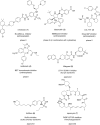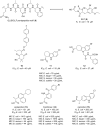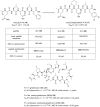Protein-protein interactions in bacteria: a promising and challenging avenue towards the discovery of new antibiotics
- PMID: 30546472
- PMCID: PMC6278769
- DOI: 10.3762/bjoc.14.267
Protein-protein interactions in bacteria: a promising and challenging avenue towards the discovery of new antibiotics
Abstract
Antibiotics are potent pharmacological weapons against bacterial infections; however, the growing antibiotic resistance of microorganisms is compromising the efficacy of the currently available pharmacotherapies. Even though antimicrobial resistance is not a new problem, antibiotic development has failed to match the growth of resistant pathogens and hence, it is highly critical to discover new anti-infective drugs with novel mechanisms of action which will help reducing the burden of multidrug-resistant microorganisms. Protein-protein interactions (PPIs) are involved in a myriad of vital cellular processes and have become an attractive target to treat diseases. Therefore, targeting PPI networks in bacteria may offer a new and unconventional point of intervention to develop novel anti-infective drugs which can combat the ever-increasing rate of multidrug-resistant bacteria. This review describes the progress achieved towards the discovery of molecules that disrupt PPI systems in bacteria for which inhibitors have been identified and whose targets could represent an alternative lead discovery strategy to obtain new anti-infective molecules.
Keywords: new antibiotics; protein–protein interactions; resistance.
Figures









Similar articles
-
Modulators of protein-protein interactions as antimicrobial agents.RSC Chem Biol. 2021 Feb 3;2(2):387-409. doi: 10.1039/d0cb00205d. eCollection 2021 Apr 1. RSC Chem Biol. 2021. PMID: 34458791 Free PMC article. Review.
-
Protein-protein complexes as targets for drug discovery against infectious diseases.Adv Protein Chem Struct Biol. 2020;121:237-251. doi: 10.1016/bs.apcsb.2019.11.012. Epub 2019 Dec 18. Adv Protein Chem Struct Biol. 2020. PMID: 32312423 Review.
-
Recent Progress in the Development of Small-Molecule FtsZ Inhibitors as Chemical Tools for the Development of Novel Antibiotics.Antibiotics (Basel). 2019 Nov 11;8(4):217. doi: 10.3390/antibiotics8040217. Antibiotics (Basel). 2019. PMID: 31717975 Free PMC article. Review.
-
Tackling Threats and Future Problems of Multidrug-Resistant Bacteria.Curr Top Microbiol Immunol. 2016;398:3-33. doi: 10.1007/82_2016_492. Curr Top Microbiol Immunol. 2016. PMID: 27406189 Review.
-
Daptomycin-resistant Enterococcus faecalis diverts the antibiotic molecule from the division septum and remodels cell membrane phospholipids.mBio. 2013 Jul 23;4(4):e00281-13. doi: 10.1128/mBio.00281-13. mBio. 2013. PMID: 23882013 Free PMC article.
Cited by
-
A Single Tool to Monitor Multiple Protein-Protein Interactions of the Escherichia coli Acyl Carrier Protein.ACS Infect Dis. 2019 Sep 13;5(9):1518-1523. doi: 10.1021/acsinfecdis.9b00150. Epub 2019 Jul 30. ACS Infect Dis. 2019. PMID: 31317739 Free PMC article.
-
Modulators of protein-protein interactions as antimicrobial agents.RSC Chem Biol. 2021 Feb 3;2(2):387-409. doi: 10.1039/d0cb00205d. eCollection 2021 Apr 1. RSC Chem Biol. 2021. PMID: 34458791 Free PMC article. Review.
-
Design of novel anti-quorum sensing peptides targeting LuxO to combat Vibrio cholerae pathogenesis.In Silico Pharmacol. 2023 Oct 27;11(1):30. doi: 10.1007/s40203-023-00172-2. eCollection 2023. In Silico Pharmacol. 2023. PMID: 37899970 Free PMC article.
-
A cell-free strategy for host-specific profiling of intracellular antibiotic sensitivity and resistance.NPJ Antimicrob Resist. 2023 Dec 18;1(1):16. doi: 10.1038/s44259-023-00018-z. NPJ Antimicrob Resist. 2023. PMID: 39843793 Free PMC article.
-
Techniques for Developing Reliable Machine Learning Classifiers Applied to Understanding and Predicting Protein:Protein Interaction Hot Spots.Methods Mol Biol. 2024;2714:235-268. doi: 10.1007/978-1-0716-3441-7_14. Methods Mol Biol. 2024. PMID: 37676603
References
-
- [Jun 22;2018 ];The top 10 causes of death. Available from: http://www.who.int/news-room/fact-sheets/detail/the-top-10-causes-of-death.
Publication types
LinkOut - more resources
Full Text Sources
Other Literature Sources
